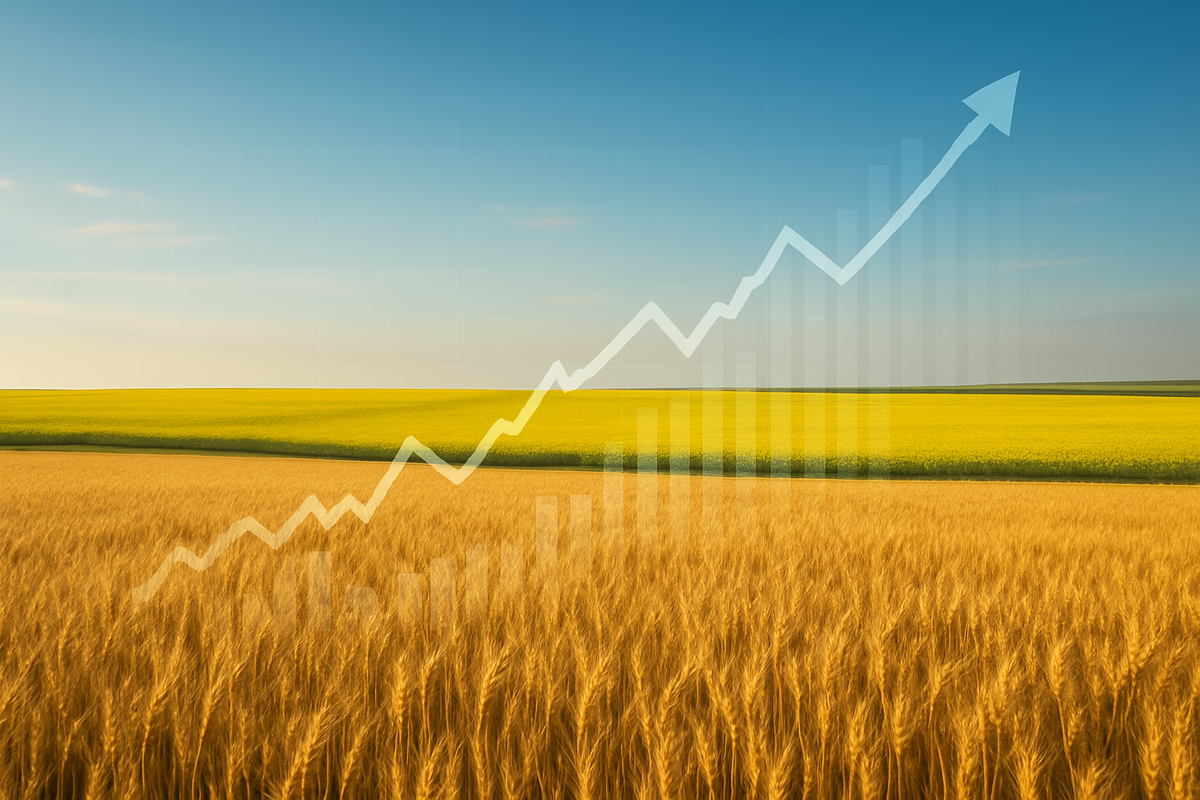
October 28, 2025 – Global commodity markets witnessed significant upward movement today, with both canola and wheat futures experiencing gains driven by a confluence of positive international trade developments and the anticipation of a pivotal Federal Reserve policy decision. This bullish sentiment signals a potential turning point for the agricultural sector, offering a glimmer of hope for producers amidst ongoing global uncertainties, yet posing fresh challenges for downstream industries and consumers.
The immediate implications are far-reaching. For farmers, particularly in major exporting nations, rising prices translate into higher potential revenues, influencing planting decisions for future seasons. However, the broader economy faces the dual edge of commodity price inflation, which could lead to increased food costs for consumers and tighter margins for food manufacturers. The market's reaction underscores the intricate link between geopolitical negotiations, monetary policy, and the fundamental supply-demand dynamics of essential food staples.
Detailed Market Dynamics and Influencing Factors
On October 28, 2025, US Wheat futures rose to 530.25 US cents per bushel, marking a 0.81% increase from the previous day's close of 526.00 US cents. Milling wheat also saw gains, generally up 5 to 7 cents across various markets. Canola futures on the Intercontinental Exchange maintained their increases, with the November contract (Nov '25, RSX25) up 1.70 to 619.20 Canadian dollars per metric tonne, and the January 2026 contract (Jan '26, RSF26) climbed 1.50 to 634.00 Canadian dollars per metric tonne. Other contracts, such as the November contract, closed at 624.70 (up 5.50) and the January contract at 638.80 (up 4.80).
This positive market swing is largely attributed to a wave of optimism surrounding international trade. U.S. Treasury Secretary Scott Bessent indicated on Sunday, October 26, 2025, that China is prepared to make "substantial purchases" of U.S. soybeans, a development that sparked a rally in soybean prices and had a significant spillover effect on canola and wheat. This framework agreement comes ahead of a critical bilateral meeting between U.S. President Donald Trump and Chinese leader Xi Jinping, expected on the sidelines of the Asia-Pacific Economic Cooperation (APEC) Economic Leaders' Meeting in Gyeongju, South Korea, from October 31 to November 1, 2025. This meeting, their first face-to-face encounter since President Trump began his current second term, is viewed as a crucial opportunity to de-escalate ongoing trade tensions.
Adding to the bullish sentiment is the widely anticipated Federal Reserve policy decision, with a quarter-point interest rate cut expected on Wednesday, October 29, 2025. This would lower the benchmark federal funds rate to a range of 3.75%-4.00%, the second consecutive reduction driven by a weakening employment picture and softer-than-expected inflation data. Lower interest rates are generally seen as a tailwind for risk assets, potentially stimulating economic activity and increasing demand for raw materials. While earlier in October, wheat prices had shown a downward trajectory due to abundant global supplies, today's rally indicates a strong market reaction to these positive macroeconomic and geopolitical signals.
Corporate Winners and Losers in a Rising Market
The upward trajectory of canola and wheat prices on October 28, 2025, creates a mixed bag of fortunes for public companies across the agricultural supply chain.
Agricultural Input Suppliers such as Nutrien Ltd. (TSX: NTR, NYSE: NTR), a major producer of potash and nitrogen, and CF Industries Holdings, Inc. (NYSE: CF), a leading manufacturer of hydrogen and nitrogen products, stand to gain. Higher commodity prices typically encourage farmers to maximize yields, leading to increased demand for fertilizers, seeds, and crop protection products from companies like Corteva, Inc. (NYSE: CTVA) and Bayer AG (ETR: BAYN). If these suppliers can manage their own rising raw material costs and pass them on, they could see improved profitability.
Grain Trading and Processing Giants like Archer-Daniels-Midland Company (NYSE: ADM) and Bunge Global SA (NYSE: BG), which recently combined with Viterra, are well-positioned to leverage market volatility. Their extensive logistics networks and risk management strategies allow them to profit from price discrepancies and the need for reliable sourcing. Higher nominal prices for the commodities they trade directly translate to higher revenue figures. For processors, profitability hinges on "crushing margins" for canola or milling margins for wheat. If they can effectively pass on increased raw material costs in the form of higher selling prices for finished products like canola oil or flour, their profitability could be maintained or improved. Australian Oilseeds Holdings Limited (NASDAQ: COOT), involved in canola oil production, would similarly depend on the spread between raw canola seed costs and canola oil sales prices.
Conversely, Food Manufacturers and Processors that use wheat and canola products as raw materials face increased input costs. Companies like General Mills (NYSE: GIS), Kellogg Company (NYSE: K), and Conagra Brands (NYSE: CAG) will likely see their cost of goods sold rise significantly. While they may attempt to offset these costs by raising consumer prices, this risks impacting sales volumes as consumers seek cheaper alternatives. Meat producers such as Tyson Foods, Inc. (NYSE: TSN) could also face higher feed costs if wheat is used in livestock feed, indirectly affecting their profitability. For these downstream users, managing pricing power and consumer elasticity will be critical to preserving profit margins.
Wider Significance and Historical Context
The rise in canola and wheat prices on October 28, 2025, is not an isolated event but rather a reflection of deeply embedded and evolving trends within global agriculture. This movement fits into a broader pattern of heightened volatility in global food markets, driven by a complex interplay of geopolitical tensions, climate change impacts, and evolving supply-demand dynamics.
Ongoing geopolitical conflicts, such as the Russia-Ukraine war, continue to disrupt critical Black Sea export routes, creating persistent uncertainty in grain trade. Simultaneously, the U.S.-China trade discussions, while currently optimistic, underscore the fragility of international trade relations and their profound impact on commodity flows. Unpredictable weather patterns, including severe droughts and variable rainfall in key agricultural regions, are increasingly impacting crop yields and quality, with climate change now a primary driver of price volatility. For instance, while some Canadian regions might see temporary benefits for wheat and canola from warmer temperatures, long-term projections suggest declining yields in other areas due to water stress.
These price movements have significant ripple effects. For the livestock feed industry, rising grain prices directly increase feed costs, subsequently driving up the cost of meat, dairy, and eggs for consumers. The biofuel sector, a major consumer of canola, also influences prices, with mandates diverting oilseeds into energy markets. Regulatory and policy implications are substantial; rising prices intensify debates around trade agreements, tariffs (like China's anti-dumping probe and tariffs on Canadian canola), and food security policies. Governments may resort to export restrictions or subsidies to stabilize domestic prices, which can inadvertently amplify global volatility. The upcoming 2025 U.S. Farm Bill, for instance, will be crucial in providing financial relief and structural support to farmers grappling with high input costs.
Historically, rapid increases in crop prices have occurred in cycles, notably in the 1970s and 2000s, often stemming from a combination of strong global demand, supply shocks (often weather-related), and geopolitical events. The Russia-Ukraine war in 2022, for example, caused unprecedented price spikes, demonstrating the market's vulnerability to such disruptions. The current environment, with its blend of trade optimism, monetary easing, and underlying climate and geopolitical risks, echoes these historical precedents, highlighting the ongoing challenge of balancing global food security with market forces.
The Road Ahead: What Comes Next?
Looking beyond October 28, 2025, the future for canola and wheat prices appears to be characterized by continued volatility, necessitating strategic adaptations across the agricultural sector.
In the short-term (late 2025 - 2026), canola futures are expected to remain volatile, influenced by potential oversupply from strong harvests in 2024/25 and the ongoing impact of China's anti-dumping investigation and tariffs on Canadian canola. Despite these headwinds, strong domestic processing demand and long-term biofuel requirements offer some price support. For wheat, short-term forecasts diverge, with some analysts predicting modest rises due to low global inventories, while others, like the World Bank, project declines due to increasing global supply. Weather conditions, geopolitical developments in the Black Sea region, and production costs will continue to be critical drivers.
In the long-term (2026 and beyond), the fundamentals for canola remain compelling, driven by increasing demand for biofuels and health-conscious consumer trends, especially with regulatory tailwinds from clean fuel standards. Growing crush capacity in Canada could reduce reliance on seed exports. For wheat, long-term forecasts are even more varied, with some predicting continued increases due to population growth and demand, while others foresee stabilization or decline if global production records are consistently met. Climate change, however, looms as a significant, unpredictable factor, potentially increasing yields in some colder regions but decreasing them in others due to water stress and soil degradation.
Market participants will need to implement strategic pivots. Risk management and hedging through futures and options will be essential to mitigate price volatility. Supply chain resilience and diversification of export markets are crucial, especially for Canadian canola producers seeking alternatives to China. Technology adoption and data analytics, including precision agriculture and AI-powered insights, will be vital for optimizing yields and minimizing costs. Farmers and agribusinesses must also embrace sustainable and climate-resilient practices to address environmental challenges and unlock opportunities in carbon credit markets.
Emerging market opportunities include the burgeoning sustainable agriculture and AgriTech sectors, offering solutions for efficiency and environmental stewardship. The growing biofuel sector will continue to drive demand for oilseeds. Challenges include persistent climate change impacts, geopolitical instability, rising input costs, and labor shortages. Potential scenarios range from a bullish market driven by severe supply shocks to a bearish one characterized by record harvests and oversupply. However, a volatile/uncertain scenario, marked by an intricate web of supply-side abundance, geopolitical tensions, and macroeconomic shifts, remains the most likely, demanding constant agility and robust market intelligence from all stakeholders.
Comprehensive Wrap-Up and Investor Outlook
Today's upward movement in canola and wheat prices on October 28, 2025, serves as a powerful reminder of the interconnectedness of global financial markets and the agricultural sector. The key takeaways from this event underscore the significant influence of international trade negotiations, such as the U.S.-China soybean framework, and monetary policy decisions, like the anticipated Fed rate cut, on commodity valuations. These factors have injected a much-needed dose of optimism into the market, providing immediate benefits for producers and traders.
Moving forward, the agricultural market is expected to remain dynamic and subject to rapid shifts. While the current bullish sentiment offers a positive outlook for the short term, investors must remain vigilant. The underlying challenges of geopolitical instability, the accelerating impacts of climate change on crop yields, and the persistent pressure of rising input costs for farmers will continue to shape market behavior. The delicate balance between global supply and demand, influenced by population growth and expanding bioeconomy needs, will dictate long-term price trends.
For investors, the coming months will require careful monitoring of several key indicators: the actual outcomes of the U.S.-China trade talks and the APEC summit, the Federal Reserve's future monetary policy decisions, and any new developments regarding global crop forecasts and weather patterns. Furthermore, tracking government policies related to agricultural subsidies, biofuel mandates, and trade tariffs will be crucial. Companies with strong risk management strategies, diversified supply chains, and a focus on sustainable agricultural practices are likely to be more resilient in this evolving landscape. The enduring significance of these staple commodities means their price movements will continue to have a profound and lasting impact on global food security, inflation, and the profitability of a wide array of public companies.
This content is intended for informational purposes only and is not financial advice






